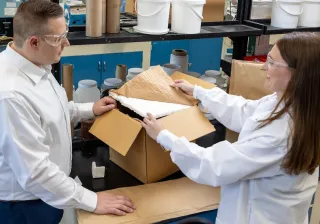The updated handprint guideline created by VTT and LUT University offers companies a transparent and rigorous way to demonstrate the positive environmental impacts of circular solutions. In addition, the handprint approach can be considered as a means to target global climate neutrality. By following the handprint guideline, companies have a science-based way to assess and communicate their positive impacts on the environment.
“The results of the project can make a significant impact on the way companies plan and communicate their environmental and circular strategies and contribute to the global effort to combat climate change. The handprint approach can be used as transparent and science-based way to prove their environmental responsibility”, says Katri Behm, Senior Scientist at VTT.
The driver for VTT’s and LUT University’s 8-year collaboration related to the handprint has been to create a robust framework for companies to demonstrate the positive environmental impacts of their offerings.
In the recent “Carbon neutrality empowered by handprint” project, the focus has been on the climate neutrality work of companies, and the positive environmental impacts of their circular economy solutions. The updated framework will help companies to calculate and communicate the good that they do in a scientific manner, without greenwashing, and thus to gain a competitive advantage in the global market.
The handprint guideline builds on internationally acknowledged ISO-standardized life cycle assessment methods but extends their scope by comparing the environmental impacts of offered solutions against an alternative baseline solution. If the offered solution decreases the footprint of other actors such as customers, a handprint is created. Thus, companies may provide solutions to affect global climate neutrality targets by reducing the footprint of others as well, instead of just their own.
Lately, the handprint guideline was updated to be applicable also for different circularity strategies that companies can apply in their circular solutions. The updated guideline has been tested with the solutions of the industry participants of the project. The guideline offers companies the possibility to recognize and communicate the more sustainable and environmentally responsible products and services for their customers.
”It’s really eye-opening to get a glimpse at the impacts of our materials across the whole value chain. Sustainability is increasingly requested by customers and consumers, and to really embed it in business and decision-making, it’s necessary to develop tools to estimate, compare and eventually quantify these impacts also on the value chain level”, says Matti Sonck, Business Development Manager at Fortum’s biorefinery program Bio2X.
“Plastics recycling case study showed that the handprint concept can be used to provide systematic comparison data of feedstocks and recycling processes. Circular solutions are needed to simultaneously reduce carbon footprints of plastics production and plastic waste incineration as well as meet end product quality requirements in different application areas of plastic products”, says Sanna Martin, Sustainability Project Manager, Borealis Polymers Oy.
"The handprint approach has been well received by the Finnish companies. Next, we are focusing our efforts on making the concept more known internationally, and also explore the possibilities of its standardization", says Kaisa Grönman, Associate Professor from LUT University.
The revised and extended handprint framework will be presented at the final seminar on 14th February 2024 and will be available for companies on the Handprint project site later.
Budget, funding and project partners
The Handprint research work has been coordinated by VTT. During its life cycle in 2016–2024), there has been three projects: Carbon Handprint (2016–2018), Environmental Handprint (2018–2021) and finally, Carbon Neutrality Empowered by Handprint (2021–2024). The work has been carried out in close cooperation by VTT, LUT University and several industrial Finnish partners. The project has been jointly funded by Business Finland, industrial partners, VTT and LUT University.
Research partners: VTT and LUT University.
Project partners: Borealis Polymers Oy, Fortum Power and Heat Oy, Oy Hartwall Ab, HyXo Oy, Höyrytys Oy, Konecranes Oy, Martela Oyj, Neste Oyj and Urbaser Oy.
What is a handprint?
The term “handprint” communicates the positive impacts of a product or organization when it reduces the footprints of others as the term “footprint” refers only to negative impacts. A product has a carbon handprint if it reduces customer’s greenhouse gas emissions. Please see this short Carbon neutrality Empowered by Handprint video on how companies should not only focus on reducing their own carbon footprint but also on identifying the opportunities to create handprints or have a look at the Carbon Handprint Guide.
Representatives of the media are welcome to join the “Carbon Neutrality Empowered by Handprint” seminar on-line on 14 February 2024 and to explore innovative solutions for a sustainable future. Programme and registrations “Carbon Neutrality Empowered by Handprint” seminar: If you wish to participate on site (VTT, Maarinkuja 3, Espoo, Finland), please contact Michael Hanf ([email protected]).








